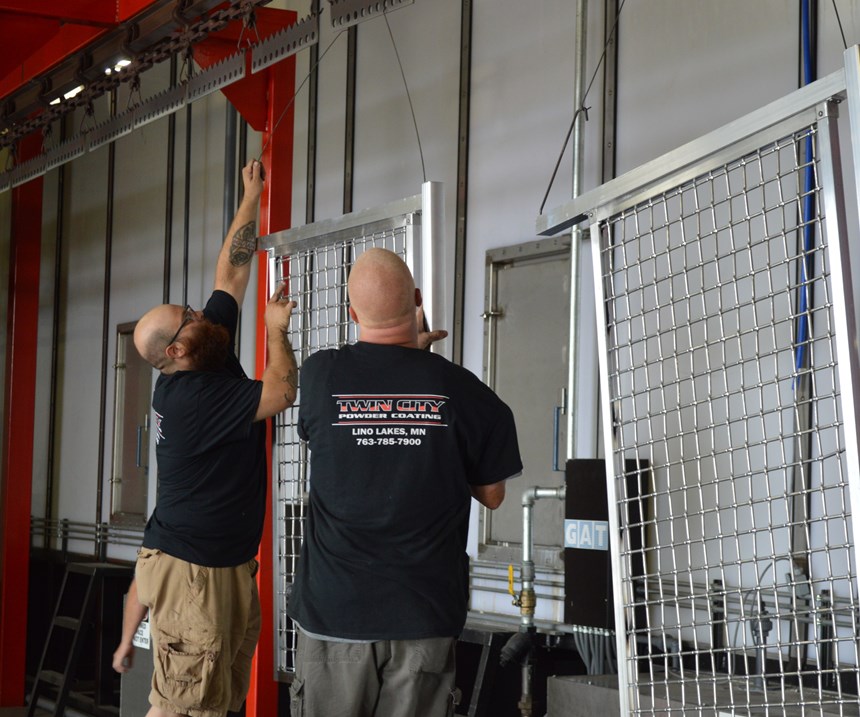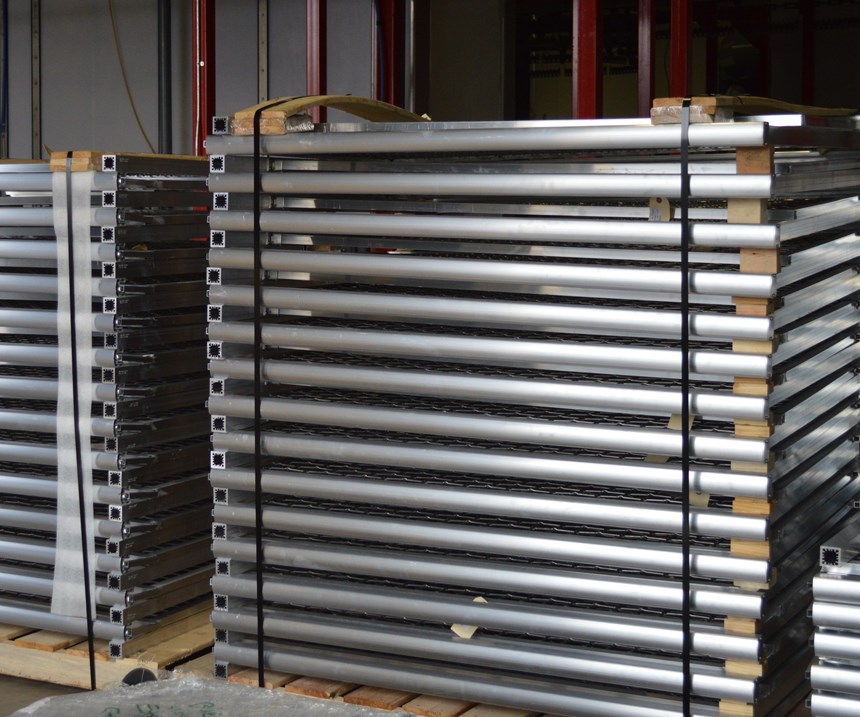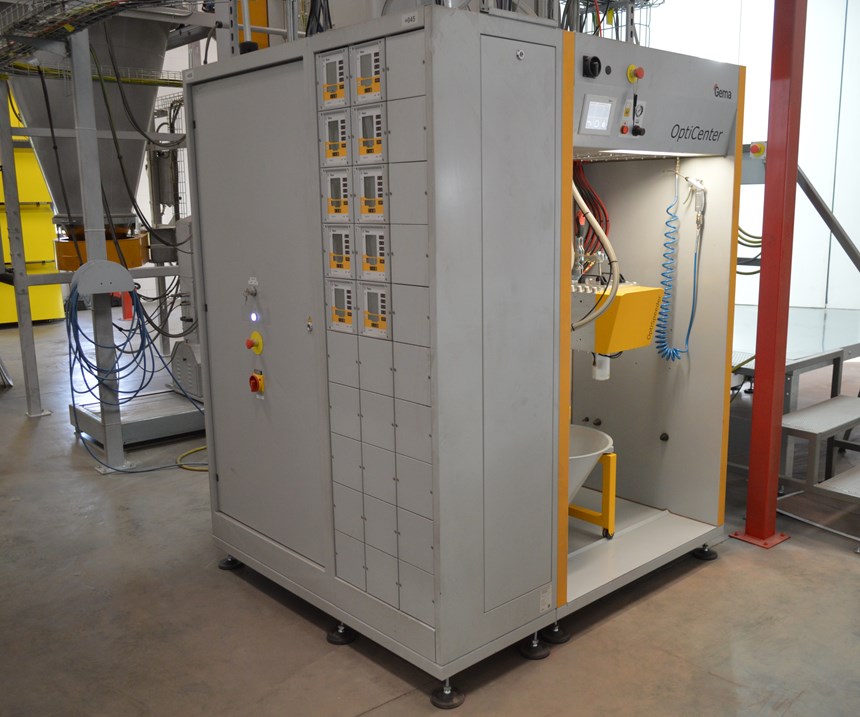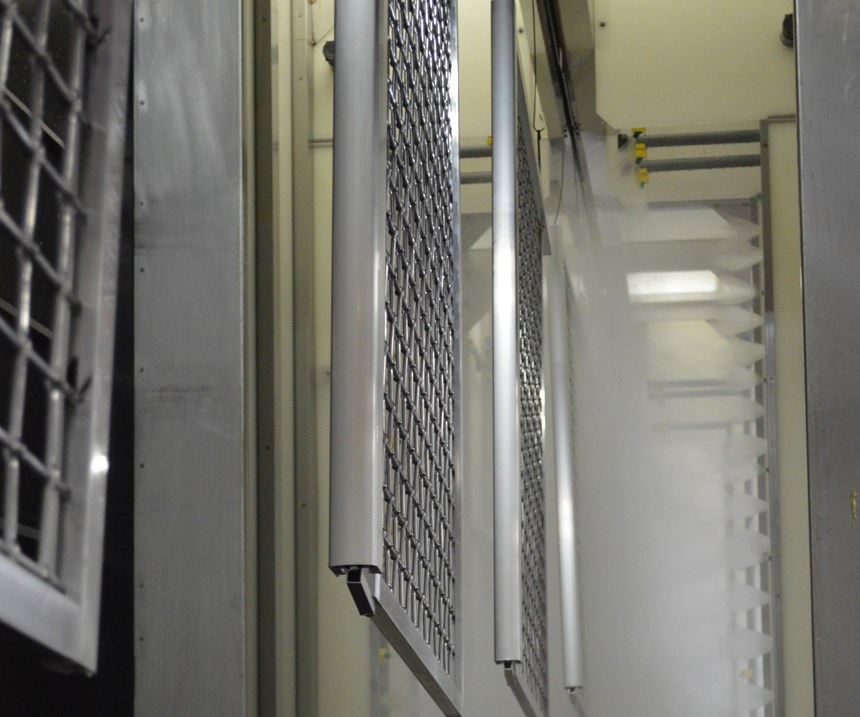You can say that Mike Russo and James Mooney are true entrepreneur business owners.The duo opened Twin City Powder Coating in Lino Lakes, Minnesota, back in 2005 and grew it into a large batch operation before expanding into the growing warrantied architectural coatings sector.
Mooney had spent 12 years in the U.S. Army, and Russo was a general manager for a major U.S. retailer, running a store with $60 million in annual sales, when they decided to take the plunge and start their powder coating operation. They started off with just themselves as employees and working in a 9,000-square-foot facility with one 30-foot oven and matching paint booths.
About eight years ago, they started investing in more batch equipment, buying more ovens and upgrading their powder booth filtration system, along with purchasing a larger wash bay and pressure washer system.
“This was a big investment to a very small company. We worked night and day to build up the batch shop,” Russo says.
As the business grew, so did the space the owners needed. Their shop now boasts 36,000 square feet of space that includes two 40-foot ovens with matching coating booths, one 8-foot oven and coating booth, six manual Gema Optiflex coating systems, and in-house media blasting services.
“About 80 percent of our customers were steel fab shops, and we were coating a lot of steel structures like snow plows and store fixtures” Russo says. “Then about seven years ago, aluminum really started to become more relevant to our customers.”
Suddenly, it seemed that Twin City’s customers had switched to aluminum, mostly parts used in commercial buildings like railings and balconies, and even some curtain wall projects.
“When that happened, we had to learn how to clean aluminum consistently,” Mooney says. “The biggest challenge was meeting the customers demand of longer warranties.”
Expanded AAMA Warranties
Even with all the new batch equipment, the biggest bottleneck in the batch shop was the wash bay. “We had to upgrade the pretreatment process,” Russo says. “IfI the parts aren’t cleaned properly, everything else will fail.”
Twin City already had achieved American Architectural Manufacturers Association (AAMA) specifications 2604 and 2605, which require at least 30 microns (1.2 mils) coating thickness for commercial and architectural-grade applications. AAMA 2604 applies to silicon polyester coatings and can offer up to a 10-year warranty; AAMA 2605 applies to coatings that contain 70 percent polyvinylidene difluoride (PVDF), a fluoropolymer resin, and offers a 20-year warranty. To meet these standards, Twin City Powder Coating went through an extensive application process that involved salt spray testing and daily process auditing.
New Pretreatment Processes
At the time, the only way to pretreat aluminum was with chromate, which comes with environmental concerns and is heavily regulated. This made it almost impossible for batch shops like Twin City to move into the architectural market until pretreatment suppliers started offering alternative chemistries.
Nanotechnology, a zirconium base non-chrome chemistry, offers a safer process for the user and the environment. Chris Oldsberg, an executive account manager at Coral Chemical, helped Twin City design and implement its wash system with Coral’s non-chrome chemistries to get the maximum corrosion protection on aluminum substrates.
“This is really the system they should have had in from the beginning,” Oldsberg says. “Now that they have this process, they can move forward.”
And the company already has begun moving forward. It has several high-end jobs with a few manufacturers, specializing in architectural curtain wall and commercial building products.
“In a manual batch operation, the longest warranty they could offer was only five years,” Russo says. “The powder coating itself will outperform a similar liquid coating every time, but without an automated line to pretreat every part consistently, the powder manufacturers just wouldn’t give you the long-term warranty.”
Mooney adds: “We have all the batch equipment and know-how to powder coat parts to a very high quality, but if we were going to offer the highest level of architectural powder coatings, an automated system was key to expanding the business and meeting the demands of our customers.”
Larger Powder Coating Capabilities
An automatic conveyorized system built by GAT Finishing Systems was installed in the fall of 2017. The system has a part window that’s 4 feet wide by 8 feet tall by 12 feet long and can turn with speeds as fast as 6 feet per minute. A four-stage, 55-foot-long, straight-line washer and a combination dry-off and cure oven were installed.
Oldsberg says the automated washer process in Stage 1 has the Coral Clene 5011 acid cleaner and deoxidizer, reverse osmosis rinses in Stages 2 and 3, and Coral’s Cor Bond Al non-chrome treatment in Stage 4.
“It’s a polymeric resin system with a pH adjustment on the last stage with zirconium,” he says. “It’s a pretty bullet-proof solution for them.”
The Gema Magic System was installed to handle the coating side of the system, which includes the OptiCenter, ZA reciprocators, eight OptiGuns and CM touchscreen controls that are all designed to work together for quick and clean color change.
“This coating system gives them the ability to not only coat faster with a more consistent finish, but now they can reclaim their coatings,” says Brian Caudill, territory manager for Gema. “This is a huge cost savings for them.”
Russo says customers have always seen the benefit of powder coating and working with his shop, but with this new equipment and certifications, Twin City can offer more, including Leadership in Energy and Environmental design (LEED) status, because powder coating produces little or no volatile organic compounds, contains no toxic compounds, and does not require a chrome-based pretreatment or primers.
“We can now give them that 20-year warranty and offer them LEED points,” Russo says.
One of the ways Twin City is trying to help grow the architectural powder coating market and its business is by offering “lunch and learns” to architects and their customers. With the help of Fiona Levin-Smith, marketing director at IFS Coatings, the company is able to offer architects an American Institute of Architects registered course about the benefits of powder coating.
“We are asking architects to have lunch with us and give us some of their limited time to show them the benefits of powder coating,” Russo says.
In March 2018, Twin City also hosted its first open house and invited architects and customers to see the new automated system and learn about the new services the shop now can offer. The owners say it was a great success.
“We were hoping to get 40 to 50 replies to our invitation, and we were shocked to get over 100 replies,” Mooney says.
The expansion into the growing architectural coatings sector required a substantial monetary investment on their part, totaling around $2.5 million in new equipment.
“But we believe in ourselves, our team and the benefits of powder coating,” Russo says.
For information, visit twincitypowdercoating.com, ifscoatings.com, coral.com, gat-systems.com and gemapowdercoating.com.
Related Content
Low-Temperature-Cure Powder Coatings Offer Unique Opportunities
An in-depth look at the advantages of low-temperature-cure powder coatings and the considerations for incorporating them into your process.
Read MorePowder Coating 4.0: Smarter, Faster, More Efficient and Connected
New tools reduce cost and waste, lower manufacturing footprint of powder coating operations.
Read MoreCuring Oven Basics
Simply heating up the substrate does not cure the coating. There are many variables to consider when choosing the best cure oven for your application...
Read MoreHow to Address Declining Powder Coating Coverage Over Time
Fine particles from reclaim could be to blame for powder coating problems that emerge over time. Avoid problems by keeping hooks clean, maintaining guns and using reclaim powder quickly to avoid accumulation of fines.
Read MoreRead Next
A ‘Clean’ Agenda Offers Unique Presentations in Chicago
The 2024 Parts Cleaning Conference, co-located with the International Manufacturing Technology Show, includes presentations by several speakers who are new to the conference and topics that have not been covered in past editions of this event.
Read MoreEpisode 45: An Interview with Chandler Mancuso, MacDermid Envio Solutions
Chandler Mancuso, technical director with MacDermid Envio discusses updating your wastewater treatment system and implementing materials recycling solutions to increase efficiencies, control costs and reduce environmental impact.
Read MoreEducation Bringing Cleaning to Machining
Debuting new speakers and cleaning technology content during this half-day workshop co-located with IMTS 2024.
Read More















.jpg;maxWidth=300;quality=90)











